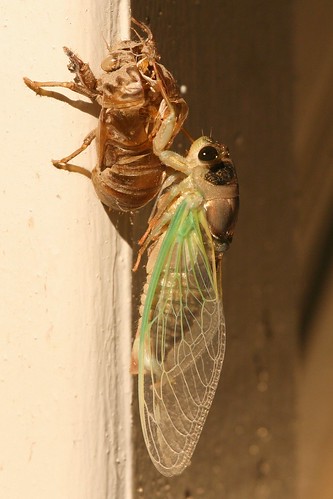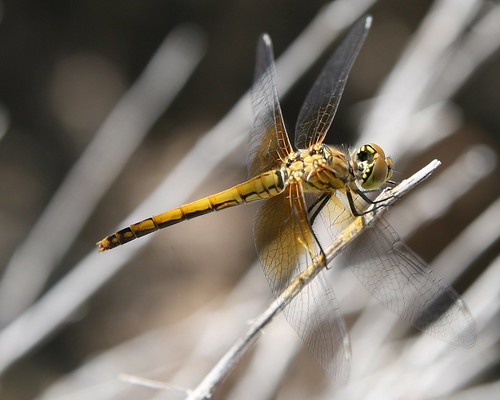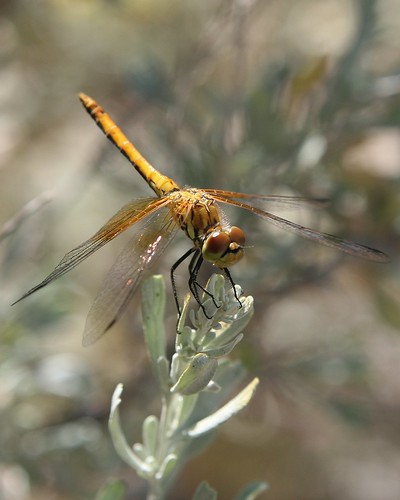It was Friday night, around 11pm. I had just returned from the airport after a business trip. It had been a long day. It started around 5:30am that morning, and I was relieved to finally be home as I shambled, zombie-like, up the sidewalk towards my front door. I had taken one step up onto the front stoop, however, when my brain registered something that my eyes had seen just a second ago. That familiar ping! of curiosity had forced its way through the fog of thought that was focused nearly exclusively on "go to bed!".
I took a step back and looked more closely. Attached to the wood of the stoop, just a few inches from the ground, was a cicada, newly emerged from the shell that it wore as a nymph. As if I had gotten a jolt of adrenaline, my mind almost immediately switched from "go to bed!" to "take a picture!".
I excitedly went inside, dumped my travel and work baggage, and began to collect the various pieces of photographic gear that I thought I would need. Do I have a charged camera battery? Which lenses should I use? Tripod? Oh yeah...it is dark outside! How will I get light on my subject? Where is that remote shutter release?
This was a challenging photographic exercise for me. While the cicada patiently sat, letting itself dry on my front stoop, I fumbled through a multitude of attempts at photographing this bug. I tried hand holding the camera at close range, and I tried it on a tripod a couple feet away. I tried it using light from only the ground level accent lights that run along the front of my house, and I tried using a flashlight, propped up on a nearby chunk of mulch (hmmm...maybe I need to invest in an external flash). I thought the flashlight was going to give me my best chance, but then its batteries started fading, and my light slowly dwindled to a pale yellowish glow. For over an hour, I sat...still in my work clothes...in the mulch of my front yard, reveling in the challenge of photographing this bug in the dark of near midnight.
Ultimately, I got something that I liked. I used a 100-400mm lens, on a tripod a few feet back from the bug. Since my flashlight was fading, I used a timed exposure. I feel like I got lucky on the focus...it was dark and the camera had very little light to use for its auto-focus feature. I manually focused the shot, but had to try multiple times...tweaking the focus just a bit after each shot until I felt like I had gotten something satisfactory.
Here is my model, perched on its old skin.
Showing posts with label Bugs. Show all posts
Showing posts with label Bugs. Show all posts
Western Meadowhawk
I thought this post was going to have another boring generic title. Something like "Dragonfly". But my very first search to identify this dragonfly led me to a site called Wild Utah, specifically the Dragonfly and Damselfly section of that site. I did the brute force approach and clicked on each link on that page so that I could compare the pictures on that site (which are fantastic!) to the pictures that I took. I eventually got to the links for Western Meadowhawk, and in particular the link for a female Western Meadowhawk. This matched my photos very nicely, so I decided my identification search was complete. My two photos were taken on the Buffalo Point Trail on Antelope Island.
Dragonflies
For me, a trip outside for the purpose of "bird watching" is really much more than just "bird watching". Sure, I am watching and listening for birds, but I also keep an eye and ear out for other critters. And if some critter actually sits still long enough for me to get a picture, then even better. Such is the case with insects.
While I have not yet invested in a macro lens, I still find opportunity to get fairly close to the occasional bug. Dragonflies are a great example. Sometimes they are skittish and will not tolerate you getting close. But other times they are just hanging out, and that is when I might get a nice up-close photograph.
These two photos are great examples. Both were taken during walks within Dutch Gap Conservation Area (DGCA) in April of this year. The first dragonfly was just sitting on his perch in direct sun. I got as close as my lens would allow (inches away) and snapped a bunch of pictures, and he never budged. The second dragonfly was more interesting. I have never seen this before, but I suppose dragonflies have to eat sometime. This particular dragonfly appeared to be eating what used to be a moth. While he ate, I was able to get fairly close for some photos.
With birds, I have a good chance of identifying them. Not so with dragonflies. I do not own a field guide (yet), so the only way I manage to identify them are getting lucky on another website, or enjoying the charity of other more knowledgeable folks. So, these two are just "dragonflies" for now.
While I have not yet invested in a macro lens, I still find opportunity to get fairly close to the occasional bug. Dragonflies are a great example. Sometimes they are skittish and will not tolerate you getting close. But other times they are just hanging out, and that is when I might get a nice up-close photograph.
These two photos are great examples. Both were taken during walks within Dutch Gap Conservation Area (DGCA) in April of this year. The first dragonfly was just sitting on his perch in direct sun. I got as close as my lens would allow (inches away) and snapped a bunch of pictures, and he never budged. The second dragonfly was more interesting. I have never seen this before, but I suppose dragonflies have to eat sometime. This particular dragonfly appeared to be eating what used to be a moth. While he ate, I was able to get fairly close for some photos.
With birds, I have a good chance of identifying them. Not so with dragonflies. I do not own a field guide (yet), so the only way I manage to identify them are getting lucky on another website, or enjoying the charity of other more knowledgeable folks. So, these two are just "dragonflies" for now.
Eastern Tailed-Blue
When I visited DGCA a few weeks ago, you could feel spring about to happen. My first Yellow-throated Warbler of the year had arrived. Eastern Bluebirds and Tree Swallows were checking out potential nest sites. And there were lots of bugs to be seen. At one point I laid my backpack on the ground so that I could change lenses on my camera and inspect a nest of Eastern Tent Caterpillars. Almost immediately I noticed three or four little blue-gray butterflies flying about and landing on my backpack. They also had a couple orange spots on the trailing end of their wings, and one tiny tail on each wing. When I got back home I used my copy of Kaufman's Field Guide to Butterflies of North America to identify what I had photographed. At first I thought it was some kind of Hairstreak. None really matched, so I looked at the Blues next. The Eastern Tailed-Blue seemed to match my photograph perfectly.
Great Pondhawk
When Tammy and I decided to drive south into the keys, our intention was simply to drive until we decided it was time to turn around. About the furthest south we got was Long Key. Here we stopped at Long Key State Park and walked the "Golden Orb Trail". Since it was getting late in the day, bird activity was next to nothing. I think we only needed one hand to count the birds we noticed. On the other hand, this beautiful dragonfly patiently perched on a twig right next to the trail and graciously allowed me to snap a few photos.
[edit: nannothemis identified this as a Great Pondhawk.]
[edit: nannothemis identified this as a Great Pondhawk.]
Prey and Predator
After I had hiked out and back on the Dike Trail at Back Bay NWR, I walked the Bay Trail (which is mostly boardwalk) behind the visitor center and parking lot. Along one section of the Bay Trail I noticed lots of large grasshoppers on either side of the boardwalk. As I walked along they would occasionally spook and propel themselves to some more comfortable resting spot. The first photo below is a photograph I got of one that decided not to vacate its current resting spot as I walked by.
Then I got to this sunny spot where a very large spider web was in the foliage on the left side of the boardwalk. Right in the middle of the web was a large black spider with a yellow pattern on his body (I think it is a Black and Yellow Argiope, also known as a Yellow Garden Spider or Yellow Garden Orbweaver). And the spider was occupied with a large meal. Caught in the spider's trap was one of those grasshoppers, its spindly legs clearly showing under the spider's binding silk.
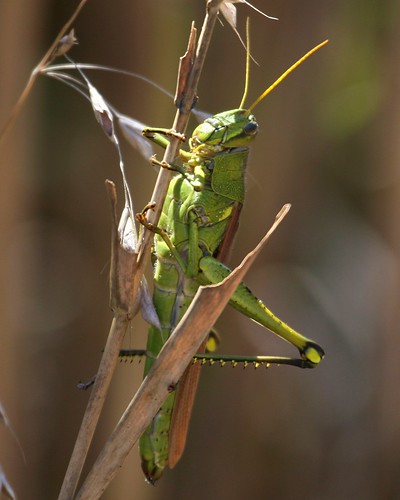
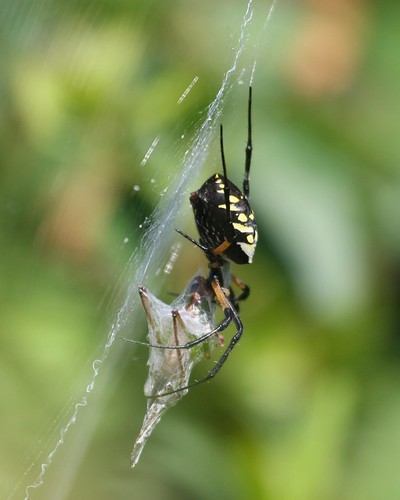
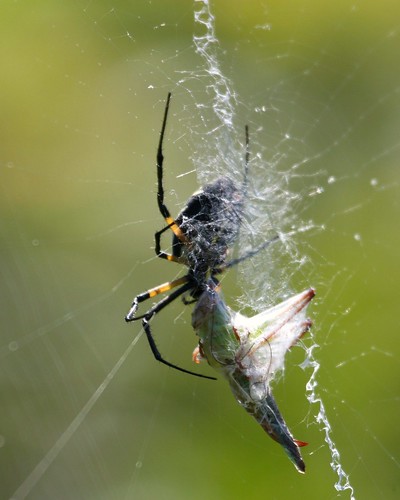
Then I got to this sunny spot where a very large spider web was in the foliage on the left side of the boardwalk. Right in the middle of the web was a large black spider with a yellow pattern on his body (I think it is a Black and Yellow Argiope, also known as a Yellow Garden Spider or Yellow Garden Orbweaver). And the spider was occupied with a large meal. Caught in the spider's trap was one of those grasshoppers, its spindly legs clearly showing under the spider's binding silk.



Northern Walking Stick
Through this past summer, as I have taken the occasional photo a butterfly, dragonfly, damselfly or something else, I have had to use various available resources on the Internet in order to identify what I was seeing. This often included me relentlessly perusing page after page of other people's bug photos in the hope of seeing something that was close to what I had photographed. This would sometimes get old, as my eyes teared up from the strain of oodles of bug photos. Or I would see some really neat looking bug that would distract me from my search.
One such neat looking bug that distracted me at least once was the Northern Walking Stick. I would see its photo, read about it, realize that they occur where I live, and then wonder why I never saw them. Maybe I just thought they were sticks on the ground and were ignorantly trampling them?
Then, this past September, when I returned home from my trip to Hog Island WMA, I was pleasantly surprised to discover a stick clinging to the side of my house. Not just any stick, but a Northern Walking Stick. Here are some photos of me and my new friend. It was an interesting challenge attempting to take pictures with a DSLR in one hand and this bug in my other hand, all while the bug tried to crawl up my arm! Guess which end is its head!



One such neat looking bug that distracted me at least once was the Northern Walking Stick. I would see its photo, read about it, realize that they occur where I live, and then wonder why I never saw them. Maybe I just thought they were sticks on the ground and were ignorantly trampling them?
Then, this past September, when I returned home from my trip to Hog Island WMA, I was pleasantly surprised to discover a stick clinging to the side of my house. Not just any stick, but a Northern Walking Stick. Here are some photos of me and my new friend. It was an interesting challenge attempting to take pictures with a DSLR in one hand and this bug in my other hand, all while the bug tried to crawl up my arm! Guess which end is its head!



Mister Mantis Says Safe Travels
With a wink and a nod, this Praying Mantis seems to be wishing Tammy and I safe travels. We depart this morning for Yellowstone National Park, via Salt Lake City and a nice Sunday drive. The weather in Yellowstone appears to be a bit sketchy this coming week, with highs in the 50s on the "warm" days. There is a chance of rain every day we will be there, and even a few mentions of snow showers.
But I don't care about cool, wet weather. Tammy and I have the appropriate clothes for that. I am looking forward to grand views, large mammals that do not want to play with us, maybe a few birds, geothermal features, and waterfalls. Of course, I will be attempting to take a lot of pictures (weather permitting), and posting the good or interesting ones in this blog as quickly as my fatigue and Internet connection allow.
Regarding Mister Mantis, he was found in Tammy's backyard a few weeks back. I am not sure whether his eyes are normal (his left "pupil" appears to be much smaller than his right "pupil"), or if he has some type of abnormality.
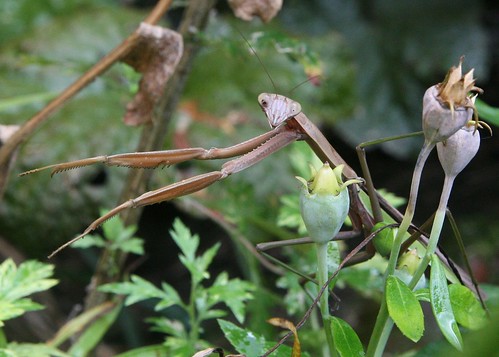
But I don't care about cool, wet weather. Tammy and I have the appropriate clothes for that. I am looking forward to grand views, large mammals that do not want to play with us, maybe a few birds, geothermal features, and waterfalls. Of course, I will be attempting to take a lot of pictures (weather permitting), and posting the good or interesting ones in this blog as quickly as my fatigue and Internet connection allow.
Regarding Mister Mantis, he was found in Tammy's backyard a few weeks back. I am not sure whether his eyes are normal (his left "pupil" appears to be much smaller than his right "pupil"), or if he has some type of abnormality.

Even More Bugs
My last post showed you several butterflies that I saw on the Doyles River Loop. This post has photos of three more bugs that I ran across.
1. A bee carrying a load of pollen.
2. A Water Strider located in a pool below the Doyles River Upper Falls.
3. A Green Stink Bug found near the Doyles River Lower Falls.
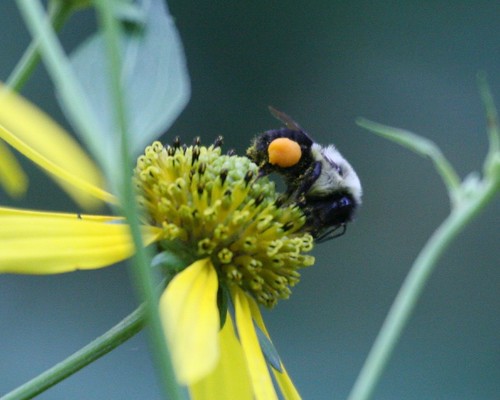

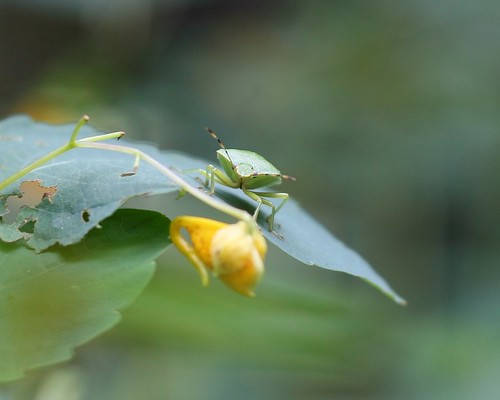
1. A bee carrying a load of pollen.
2. A Water Strider located in a pool below the Doyles River Upper Falls.
3. A Green Stink Bug found near the Doyles River Lower Falls.



Butterflies of Doyles River Loop
If you hike anywhere in Shenandoah during the month of August, you will see lots of butterflies. Our recent hike on the Doyles River Loop was no exception. I managed to get photographs of four different species of butterfly on the hike:
1. Spicebush Swallowtail.
2. Great Spangled Fritillary.
3. Silver-spotted Skipper. Not a very good photo.
4. Hackberry Emperor. Tammy is the hand model.



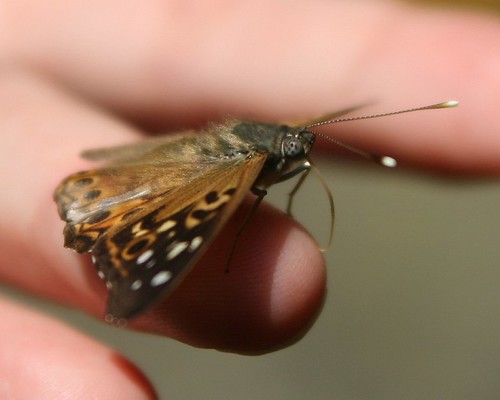
1. Spicebush Swallowtail.
2. Great Spangled Fritillary.
3. Silver-spotted Skipper. Not a very good photo.
4. Hackberry Emperor. Tammy is the hand model.




The Zen of the Fly
While traipsing about my backyard, I came across this little fly sitting all alone at the very tip of a pointy green leaf. I snapped a couple of photos of him and his bulbous eyes and then moved on without much thought.
Last week, however, I was trolling through my photos and I found this one. It is not a great photo. My subject, the fly on the leaf, is not in excellent focus. But the more I looked at it, the more I liked it. Maybe it is the overall greenness of the picture, and the way the leaf fades into the blur of the background. Or maybe it is the way that fly is perched on the tip of that leaf. I even applied some anthropomorphic magic to the fly, and imagined him there, perched on that delicate edge, watching the world go by, just relaxed and taking it all in. Kind of like I would do if I had a nice "see for miles and miles" type view.
Anyway, I liked it enough to make it the background picture on my work PC's desktop. It helps me relax at work. Your mileage may vary.
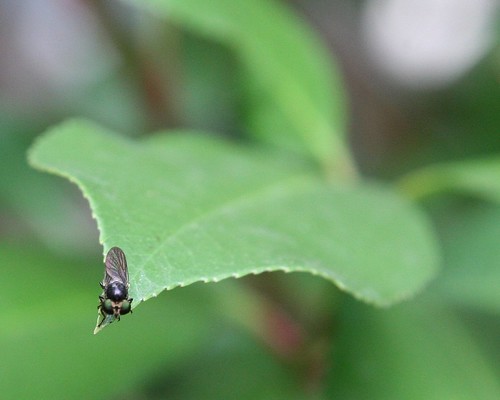
Last week, however, I was trolling through my photos and I found this one. It is not a great photo. My subject, the fly on the leaf, is not in excellent focus. But the more I looked at it, the more I liked it. Maybe it is the overall greenness of the picture, and the way the leaf fades into the blur of the background. Or maybe it is the way that fly is perched on the tip of that leaf. I even applied some anthropomorphic magic to the fly, and imagined him there, perched on that delicate edge, watching the world go by, just relaxed and taking it all in. Kind of like I would do if I had a nice "see for miles and miles" type view.
Anyway, I liked it enough to make it the background picture on my work PC's desktop. It helps me relax at work. Your mileage may vary.

Spiders
At some point in the middle of July, when it was too hot to hike on the weekends, I took a stroll through my backyard looking for bugs and flowers that would be good photographic fodder. I have a tiny backyard, with an interstate just beyond the fence, so any strolling does not take much time. Nonetheless, there are plenty of bugs if you look close enough. And even some flowers.
Here are some pictures of spiders that I took in my backyard in July. After spending about 30 minutes attempting to identify the spider in the first picture (and not succeeding), I gave up and am simply calling these three photos "striped spider with egg sack", "orange and black spider" and "close up on baby spiders".
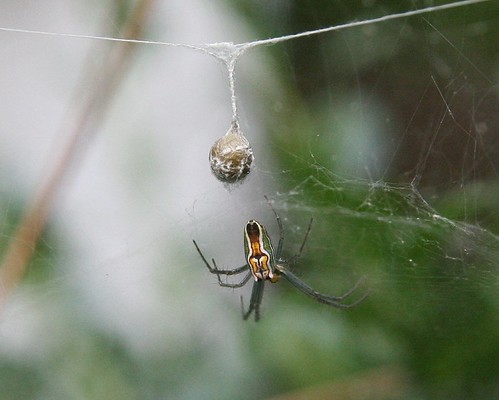

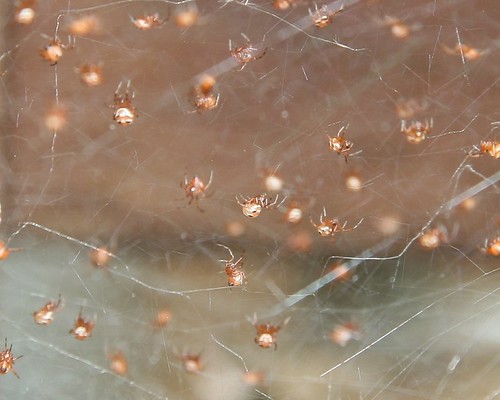
Here are some pictures of spiders that I took in my backyard in July. After spending about 30 minutes attempting to identify the spider in the first picture (and not succeeding), I gave up and am simply calling these three photos "striped spider with egg sack", "orange and black spider" and "close up on baby spiders".



Hackberry Emperor
After I finished walking the River Trail at DGCA and had gotten back to my pickup truck, I took off my Camelbak and laid it in the bed of the truck. When I came back around a moment later, a butterfly had landed on the pack and was giving it lots of attention. I had no idea what it was then, but the photo opportunity was excellent because the butterfly was hardly moving.
I did some searching this morning and have determined that this butterfly is a Hackberry Emperor. One of the interesting things I read was that this butterfly likes to "take sweat from humans", which probably explains why it was so interested in my pack.
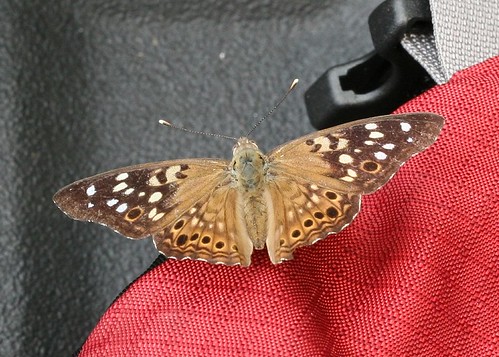
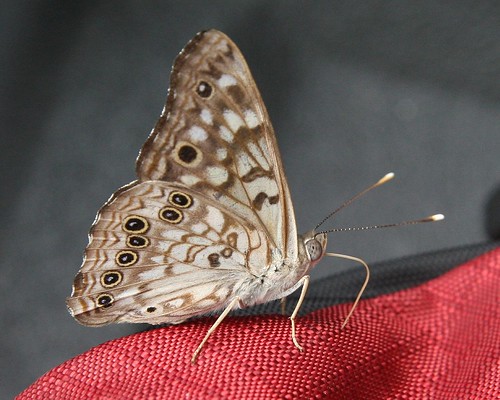
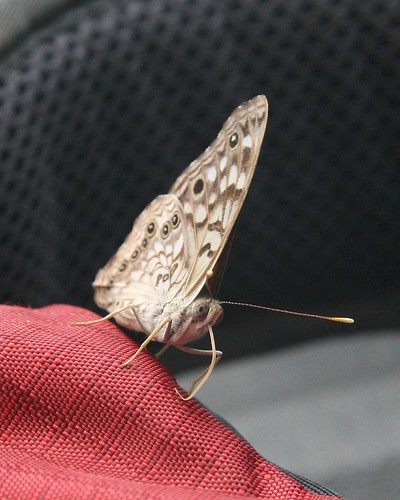
I did some searching this morning and have determined that this butterfly is a Hackberry Emperor. One of the interesting things I read was that this butterfly likes to "take sweat from humans", which probably explains why it was so interested in my pack.



Questionmark
When we got to the Rose River Falls on our hike a couple weekends back, we took a few moments to catch our breath. We were in the middle of the climb back up to the Skyline Drive, so we needed the rest. But there were also the falls to look at, and about a dozen butterflies in and around this one tree next to the trail. Most of them were Red Admirals, but there was at least one Question Mark.
That's right. There is a butterfly named after punctuation. Actually, there is another butterfly that looks very similar to the Question Mark called an Eastern Comma. So that would be at least two butterflies named after punctuation. Not sure if there are any more.
The Question Mark gets its name from the underside of its wings (see the second picture). The underside is much browner, and cryptically patterned. In the pattern, however, is a small question mark shaped white line. It is really a small white curve with a white dot next to it. On the Eastern Comma (not pictured, but follow the link above to see someone else's picture) there is no white dot, but there is still a hooked white curve. There are other differences between the two on the top side, with the pattern of black dots on the orange wings.
The first picture here shows the top side of the Question Mark. The second picture shows the Question Mark with its wings "up", giving you a blurry glimpse of its signature field mark (look towards the back of the near wing and you will see the curved white line and white dot on the brownish wing).
Yeah, it is something of a reach to say that the white curve and dot look like that thing you put at the end of a sentence that asks a question. Right???

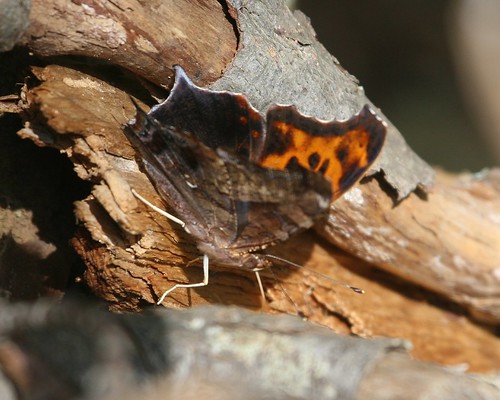
That's right. There is a butterfly named after punctuation. Actually, there is another butterfly that looks very similar to the Question Mark called an Eastern Comma. So that would be at least two butterflies named after punctuation. Not sure if there are any more.
The Question Mark gets its name from the underside of its wings (see the second picture). The underside is much browner, and cryptically patterned. In the pattern, however, is a small question mark shaped white line. It is really a small white curve with a white dot next to it. On the Eastern Comma (not pictured, but follow the link above to see someone else's picture) there is no white dot, but there is still a hooked white curve. There are other differences between the two on the top side, with the pattern of black dots on the orange wings.
The first picture here shows the top side of the Question Mark. The second picture shows the Question Mark with its wings "up", giving you a blurry glimpse of its signature field mark (look towards the back of the near wing and you will see the curved white line and white dot on the brownish wing).
Yeah, it is something of a reach to say that the white curve and dot look like that thing you put at the end of a sentence that asks a question. Right???


Red Admiral
While walking up Keyser Run Fire Road (which, in some maps, is named Jinny Gray Road), it seemed like there was always one of these black butterflies with an orange stripe on their wings fluttering about. I managed to get this photo while one paused on a rock by the trail. Some searching on Google led me to decide that I had taken a picture of a Red Admiral.


Gypsy Moth Mayhem
While hiking the Sugarloaf Trail, Tammy and I kept getting tricked into thinking it was about to rain. The occasional clouds that obscured the sun, and being under the canopy of trees, caused the light to sometimes dim as if rain clouds were rolling in. And then we would notice the sound of what we thought were raindrops falling through the trees. But then the sun would come back out, and that sound of raindrops would persist. And we never felt a single raindrop.
So we focused on that sound and decided that it was like a really, really slow rain. Almost like the rain on the very edge of a storm. Since nothing was wet and it was really more sunny than cloudy, we knew it could not be rain. But that sound of something falling through the leaves was always there.
When we later stopped to examine some caterpillars on the side of the trail, we finally put two and two together. There were lots of caterpillars. At first, I was assuming these were Eastern Tent Caterpillars, but after some searching on Google, a bit of reading (here and here) and some picture comparisons, I have decided that these were Gypsy Moth Caterpillars. The Gypsy Moth is an introduced species in North America. We have Étienne Léopold Trouvelot, and his fleeting interest in entomology, to thank for this.
The caterpillars were happily munching on leaves. Everywhere you looked you saw caterpillars on leaves, and the leaves had holes in them or giant chunks missing from them. And when you examined the trail closely, you noticed bits of green leaves everywhere. Our conclusion was that the massive number of Gypsy Moth Caterpillars were chowing down on the leaves in the canopy, and an endless stream of leaf pieces were falling down to the ground.


So we focused on that sound and decided that it was like a really, really slow rain. Almost like the rain on the very edge of a storm. Since nothing was wet and it was really more sunny than cloudy, we knew it could not be rain. But that sound of something falling through the leaves was always there.
When we later stopped to examine some caterpillars on the side of the trail, we finally put two and two together. There were lots of caterpillars. At first, I was assuming these were Eastern Tent Caterpillars, but after some searching on Google, a bit of reading (here and here) and some picture comparisons, I have decided that these were Gypsy Moth Caterpillars. The Gypsy Moth is an introduced species in North America. We have Étienne Léopold Trouvelot, and his fleeting interest in entomology, to thank for this.
The caterpillars were happily munching on leaves. Everywhere you looked you saw caterpillars on leaves, and the leaves had holes in them or giant chunks missing from them. And when you examined the trail closely, you noticed bits of green leaves everywhere. Our conclusion was that the massive number of Gypsy Moth Caterpillars were chowing down on the leaves in the canopy, and an endless stream of leaf pieces were falling down to the ground.


Mating Damselflies
Tammy and I came across this pair of Damselflies mating on a leaf towards the end of our hike at Ragged Mountain Natural Area. This picture isn't sharp, but it is clear enough for you to get the gist of their contortion. Quite an odd shape they make. If you are a sentimentalist, then perhaps you see a heart laying on its side. I am too logical, so all I see are two bugs on a leaf.


Smile for the camera
When I got to the end of the River Trail within DGCA, where the boardwalk used to be, I stood for a few minutes to watch and listen. It was during that time that I noticed several dragonflies (I am pretty sure this is not a damselfly...according to Wikipedia, most dragonflies hold their wings horizontally away from the body). To me, they are always interesting to look at, especially up close. This one looks as if he is aware of me and is smiling for the picture I am taking.
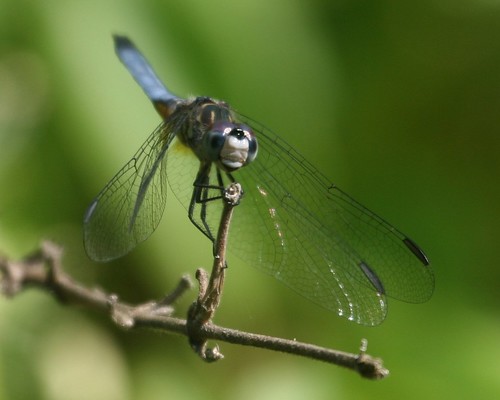

Summer Tanager
As I speculated yesterday, my field trip took me back to Peveto Woods on the Cameron Coast of Louisiana. The birding was about the same. There were birds to be seen, but no great fallout of migrants. The best photos of today's visit were of a male and female Summer Tanager. The male is red. The third photo shows one of the favorite meals of a Summer Tanager: bees. They snatch the bees out of the air and then rub them on trees to remove the stinger.






Subscribe to:
Posts (Atom)
